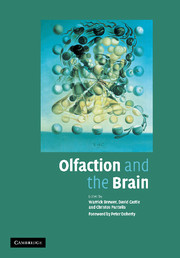Book contents
- Frontmatter
- Contents
- Foreword
- Preface
- List of Contributors
- Section I Neurology, Neurophysiology and Neuropsychology: Olfactory Clues to Brain Development and Disorder
- Section II Social Functioning: Role of Evolution, Genetics and Gender
- Section III Assessment and Disorders of Olfaction
- 13 Assessment of Olfaction
- 14 Olfactory Impairment in Neuropsychiatric Disorders
- 15 Olfaction in Parkinsonian Syndromes
- 16 Olfaction in Psychosis
- 17 Olfactory Hallucinations
- 18 Delusions of Body Malodour: The Olfactory Reference Syndrome
- Index
- Plate section
- References
18 - Delusions of Body Malodour: The Olfactory Reference Syndrome
from Section III - Assessment and Disorders of Olfaction
Published online by Cambridge University Press: 17 August 2009
- Frontmatter
- Contents
- Foreword
- Preface
- List of Contributors
- Section I Neurology, Neurophysiology and Neuropsychology: Olfactory Clues to Brain Development and Disorder
- Section II Social Functioning: Role of Evolution, Genetics and Gender
- Section III Assessment and Disorders of Olfaction
- 13 Assessment of Olfaction
- 14 Olfactory Impairment in Neuropsychiatric Disorders
- 15 Olfaction in Parkinsonian Syndromes
- 16 Olfaction in Psychosis
- 17 Olfactory Hallucinations
- 18 Delusions of Body Malodour: The Olfactory Reference Syndrome
- Index
- Plate section
- References
Summary
He said: ‘For the past three months I've been giving off a body odor. It smells like a swamp, dug up mud, a rotten smell; it comes from my guts. I can't go anywhere. I don't want to go with my friends, and I think I've lost them on account of that …. I smell it through my nose. I smell it all over the body. I think it stays 6 feet around me. It smells more in front of me. Sometimes it smells like a swamp. I never experienced something similar….’
Gabriel Garcia MarquezIntroduction
The olfactory reference syndrome (ORS) is an under-recognised type of delusional disorder that has been described for more than a century. It consists of a false belief that one emits an offensive body odour and is often accompanied by prominent delusions of reference and repetitive behaviours aimed at checking or reducing the perceived odour. ORS is associated with significant distress and impaired functioning, especially in the social realm. Many patients seek nonpsychiatric treatment from gastroenterologists, dermatologists, proctologists, dentists and other specialists; however, such treatments appear to be generally ineffective. In contrast, although data are limited, certain psychotropic medications and behavioural interventions are promising.
This chapter discusses ORS's history, clinical features, prevalence, treatment response, possible pathogenesis, nosological status and relationship to other psychiatric disorders, including mood disorders, schizophrenia, social phobia, and obsessive compulsive disorder (OCD).
Keywords
- Type
- Chapter
- Information
- Olfaction and the Brain , pp. 334 - 354Publisher: Cambridge University PressPrint publication year: 2006
References
- 10
- Cited by



